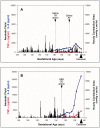Choriodecidual group B streptococcal inoculation induces fetal lung injury without intra-amniotic infection and preterm labor in Macaca nemestrina
- PMID: 22216148
- PMCID: PMC3244436
- DOI: 10.1371/journal.pone.0028972
Choriodecidual group B streptococcal inoculation induces fetal lung injury without intra-amniotic infection and preterm labor in Macaca nemestrina
Erratum in
- PLoS One. 2012;7(8). doi: 10.1371/annotation/5abb9d73-7eca-4804-aad6-ebac580a926b
Abstract
Background: Early events leading to intrauterine infection and fetal lung injury remain poorly defined, but may hold the key to preventing neonatal and adult chronic lung disease. Our objective was to establish a nonhuman primate model of an early stage of chorioamnionitis in order to determine the time course and mechanisms of fetal lung injury in utero.
Methodology/principal findings: Ten chronically catheterized pregnant monkeys (Macaca nemestrina) at 118-125 days gestation (term=172 days) received one of two treatments: 1) choriodecidual and intra-amniotic saline (n=5), or 2) choriodecidual inoculation of Group B Streptococcus (GBS) 1×10(6) colony forming units (n=5). Cesarean section was performed regardless of labor 4 days after GBS or 7 days after saline infusion to collect fetal and placental tissues. Only two GBS animals developed early labor with no cervical change in the remaining animals. Despite uterine quiescence in most cases, blinded review found histopathological evidence of fetal lung injury in four GBS animals characterized by intra-alveolar neutrophils and interstitial thickening, which was absent in controls. Significant elevations of cytokines in amniotic fluid (TNF-α, IL-8, IL-1β, IL-6) and fetal plasma (IL-8) were detected in GBS animals and correlated with lung injury (p<0.05). Lung injury was not directly caused by GBS, because GBS was undetectable in amniotic fluid (~10 samples tested/animal), maternal and fetal blood by culture and polymerase chain reaction. In only two cases was GBS cultured from the inoculation site in low numbers. Chorioamnionitis occurred in two GBS animals with lung injury, but two others with lung injury had normal placental histology.
Conclusions/significance: A transient choriodecidual infection can induce cytokine production, which is associated with fetal lung injury without overt infection of amniotic fluid, chorioamnionitis or preterm labor. Fetal lung injury may, thus, occur silently without symptoms and before the onset of the fetal systemic inflammatory response syndrome.
© 2011 Adams Waldorf et al.
Conflict of interest statement
Figures




Similar articles
-
Amniotic fluid interleukin 6 and interleukin 8 are superior predictors of fetal lung injury compared with maternal or fetal plasma cytokines or placental histopathology in a nonhuman primate model.Am J Obstet Gynecol. 2021 Jul;225(1):89.e1-89.e16. doi: 10.1016/j.ajog.2020.12.1214. Epub 2021 Jan 4. Am J Obstet Gynecol. 2021. PMID: 33412130 Free PMC article.
-
Choriodecidual infection downregulates angiogenesis and morphogenesis pathways in fetal lungs from Macaca nemestrina.PLoS One. 2012;7(10):e46863. doi: 10.1371/journal.pone.0046863. Epub 2012 Oct 9. PLoS One. 2012. PMID: 23056493 Free PMC article.
-
Group B streptococcal infection of the choriodecidua induces dysfunction of the cytokeratin network in amniotic epithelium: a pathway to membrane weakening.PLoS Pathog. 2014 Mar 6;10(3):e1003920. doi: 10.1371/journal.ppat.1003920. eCollection 2014 Mar. PLoS Pathog. 2014. PMID: 24603861 Free PMC article.
-
Inflammation in pregnancy: its roles in reproductive physiology, obstetrical complications, and fetal injury.Nutr Rev. 2007 Dec;65(12 Pt 2):S194-202. doi: 10.1111/j.1753-4887.2007.tb00362.x. Nutr Rev. 2007. PMID: 18240548 Review.
-
Exposure to Group B Streptococcus-induced chorioamnionitis alters the proteome of placental extracellular vesicles.Placenta. 2025 Jan 22:S0143-4004(25)00018-9. doi: 10.1016/j.placenta.2025.01.008. Online ahead of print. Placenta. 2025. PMID: 39864996 Review.
Cited by
-
A Broad Spectrum Chemokine Inhibitor Prevents Preterm Labor but Not Microbial Invasion of the Amniotic Cavity or Neonatal Morbidity in a Non-human Primate Model.Front Immunol. 2020 Apr 30;11:770. doi: 10.3389/fimmu.2020.00770. eCollection 2020. Front Immunol. 2020. PMID: 32425945 Free PMC article.
-
Amniotic fluid interleukin 6 and interleukin 8 are superior predictors of fetal lung injury compared with maternal or fetal plasma cytokines or placental histopathology in a nonhuman primate model.Am J Obstet Gynecol. 2021 Jul;225(1):89.e1-89.e16. doi: 10.1016/j.ajog.2020.12.1214. Epub 2021 Jan 4. Am J Obstet Gynecol. 2021. PMID: 33412130 Free PMC article.
-
Group B streptococcal infections in pregnancy and early life.Clin Microbiol Rev. 2025 Mar 13;38(1):e0015422. doi: 10.1128/cmr.00154-22. Epub 2024 Nov 25. Clin Microbiol Rev. 2025. PMID: 39584819 Review.
-
Maternal group B Streptococcus recto vaginal colonization increases the odds of stillbirth: evidence from Eastern Ethiopia.BMC Pregnancy Childbirth. 2018 Oct 19;18(1):410. doi: 10.1186/s12884-018-2044-2. BMC Pregnancy Childbirth. 2018. PMID: 30340553 Free PMC article.
-
Non-human Primate Models to Investigate Mechanisms of Infection-Associated Fetal and Pediatric Injury, Teratogenesis and Stillbirth.Front Genet. 2021 Jul 5;12:680342. doi: 10.3389/fgene.2021.680342. eCollection 2021. Front Genet. 2021. PMID: 34290739 Free PMC article. Review.
References
-
- Behrman RE, Stith Butler A, editors. Washington, D.C.: The National Academies Press; 2006. Preterm Birth: Causes, Consequences, and Prevention; - PubMed
-
- Goldenberg RL, Hauth JC, Andrews WW. Intrauterine infection and preterm delivery. N Engl J Med. 2000;342:1500–1507. - PubMed
-
- Romero R, Brody DT, Oyarzun E, Mazor M, Wu YK, et al. Infection and labor. III. Interleukin-1: a signal for the onset of parturition. Am J Obstet Gynecol. 1989;160:1117–1123. - PubMed
-
- Romero R, Ceska M, Avila C, Mazor M, Behnke E, et al. Neutrophil attractant/activating peptide-1/interleukin-8 in term and preterm parturition. Am J Obstet Gynecol. 1991;165:813–820. - PubMed
-
- Yoon BH, Romero R, Jun JK, Park KH, Park JD, et al. Amniotic fluid cytokines (interleukin-6, tumor necrosis factor-alpha, interleukin-1 beta, and interleukin-8) and the risk for the development of bronchopulmonary dysplasia. Am J Obstet Gynecol. 1997;177:825–830. - PubMed
Publication types
MeSH terms
Grants and funding
LinkOut - more resources
Full Text Sources
Medical

